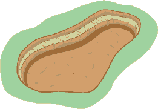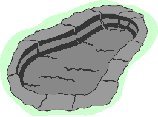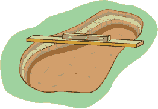 |
|||||
| 3. Installing Your Pond |
|||||
 |
 |
||||
|
1) Have a site selected and a basic idea roughly drawn on paper. |
9) Carefully unfold your liner. The liner will be easier to handle with two people. Drape the liner over the pond and gently let it fall into place. Letting the liner lie in the sun in this position for a time makes it more pliable and easier to handle. Make sure there is an even overlap all the way around. |
||||
 |
 |
||||
| 5) Check and level the entire rim of the pond by placing a straight 2 x 4 with a level on it across the pond. If your pond is too large for this method, stakes can be temporarily placed in the center of the pond. Level these stakes to each other, then level all points along the pond edge to the center stakes. Remove or add soil at high or low points until the entire rim is level with the center. One section should be slightly lower to allow run off. Direct this low point away from traffic and leisure areas of the garden. 6) A shallow 12-18 inch wide ledge should be cut beyond the rim to allow for decorative fieldstone, mulching, or landscaping that will cover the overhanging liner. 7) Remove all sharp objects from the pond. No rocks, roots or sharp material should be present in any area. 8) The bottom of any questionable ground should be lined with sand approximately one inch deep. This is a good practice for all ponds, however, it is not always necessary. |
12) Fill the pond. |
||||
 |
|||||
| 13) After the pond is full, the liner can be trimmed leaving a flap 8-18” around the entire pond. This length depends on your edging plan. 14) The pond is now ready for the coping or decorative edging. This should extend a couple of inches over the edge to protect the liner from UV rays. Please see the drawings for ideas on edging. 15) Following conditioning your pond you are ready to add plants and fish to your pond. |
|||||
|
|
|||||
|
|||||